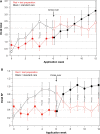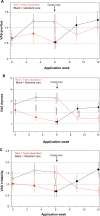Barrier protective use of skin care to prevent chemotherapy-induced cutaneous symptoms and to maintain quality of life in patients with breast cancer
- PMID: 25114589
- PMCID: PMC4126578
- DOI: 10.2147/BCTT.S61699
Barrier protective use of skin care to prevent chemotherapy-induced cutaneous symptoms and to maintain quality of life in patients with breast cancer
Abstract
Purpose: Chemotherapy with anthracyclines, taxanes, or alkylating agents often causes cutaneous side effects. Nonspecific inhibition of the proliferative activity of keratinocytes has antidifferentiation effects that lead to defects in the barrier function and, thus, to dry, itchy, and irritable skin. These cutaneous symptoms reduce the quality of life of the patients considerably. Conditioning with topical application of niacinamide uses the cytoprotective and barrier stabilizing effect of vitamin B3.
Patients and methods: A multicenter randomized crossover study investigated the influence of the test preparation on the quality of life compared to standard care for 73 patients with breast cancer undergoing adjuvant or neoadjuvant cytostatic therapy. Primary target parameter was the Dermatology Life Quality Index with its respective subscales after 6 weeks of a twice-daily application of the respective preparations. Additionally, specific symptoms such as pruritus, dryness, and irritability have been assessed using visual analog scales.
Results: Regarding the total score of the Dermatology Life Quality Index, no relevant differences could be observed. However, the results for the "symptoms and feelings" subscale show a significant advantage in favor of the test preparation. Significant superiority of the test preparation could also be observed in the secondary target parameters, the visual analog scales (P<0.05).
Conclusion: The results show for the first time a significant superiority of prophylactic application of niacinamide for maintaining quality of life while undergoing cytostatic treatment.
Keywords: anthracycline; chemotherapy; niacinamide; supportive therapy; taxane.
Figures



Similar articles
-
Health-related quality of life in early breast cancer.Dan Med Bull. 2010 Sep;57(9):B4184. Dan Med Bull. 2010. PMID: 20816024
-
Hygiene and emollient interventions for maintaining skin integrity in older people in hospital and residential care settings.Cochrane Database Syst Rev. 2020 Jan 23;1(1):CD011377. doi: 10.1002/14651858.CD011377.pub2. Cochrane Database Syst Rev. 2020. PMID: 32006460 Free PMC article.
-
Menopausal symptoms in relationship to breast cancer-specific quality of life after adjuvant cytotoxic treatment in young breast cancer survivors.Health Qual Life Outcomes. 2020 Feb 10;18(1):24. doi: 10.1186/s12955-020-1283-x. Health Qual Life Outcomes. 2020. PMID: 32041627 Free PMC article.
-
The Impact of Age on Quality of Life in Breast Cancer Patients Receiving Adjuvant Chemotherapy: A Comparative Analysis From the Prospective Multicenter Randomized ADEBAR trial.Clin Breast Cancer. 2017 Apr;17(2):100-106. doi: 10.1016/j.clbc.2016.10.008. Epub 2016 Oct 19. Clin Breast Cancer. 2017. PMID: 27884722
-
Overview of resistance to systemic therapy in patients with breast cancer.Adv Exp Med Biol. 2007;608:1-22. doi: 10.1007/978-0-387-74039-3_1. Adv Exp Med Biol. 2007. PMID: 17993229 Review.
Cited by
-
Phytotherapy and Nutritional Supplements on Breast Cancer.Biomed Res Int. 2017;2017:7207983. doi: 10.1155/2017/7207983. Epub 2017 Aug 6. Biomed Res Int. 2017. PMID: 28845434 Free PMC article. Review.
-
[Therapeutic peculiarities in diseases of the nipple skin].Dermatologie (Heidelb). 2022 Nov;73(11):873-879. doi: 10.1007/s00105-022-05031-3. Epub 2022 Jul 11. Dermatologie (Heidelb). 2022. PMID: 35925215 Free PMC article. Review. German.
-
The Impact of Immunological Checkpoint Inhibitors and Targeted Therapy on Chronic Pruritus in Cancer Patients.Biomedicines. 2020 Dec 22;9(1):2. doi: 10.3390/biomedicines9010002. Biomedicines. 2020. PMID: 33375183 Free PMC article. Review.
-
Updated Meta-Analysis on Vitamin Supplementation for Chronic Pruritus: Expanding Evidence Beyond Vitamin D.Int J Mol Sci. 2025 Apr 18;26(8):3840. doi: 10.3390/ijms26083840. Int J Mol Sci. 2025. PMID: 40332575 Free PMC article.
-
The role of dermocosmetics in the management of cancer-related skin toxicities: international expert consensus.Support Care Cancer. 2023 Nov 4;31(12):672. doi: 10.1007/s00520-023-08116-4. Support Care Cancer. 2023. PMID: 37925388 Free PMC article. Review.
References
-
- Petrie W, Logan J, DeGrasse C. Research review of the supportive care needs of spouses of women with breast cancer. Oncol Nurs Forum. 2001;28:1601–1607. - PubMed
LinkOut - more resources
Full Text Sources
Other Literature Sources

